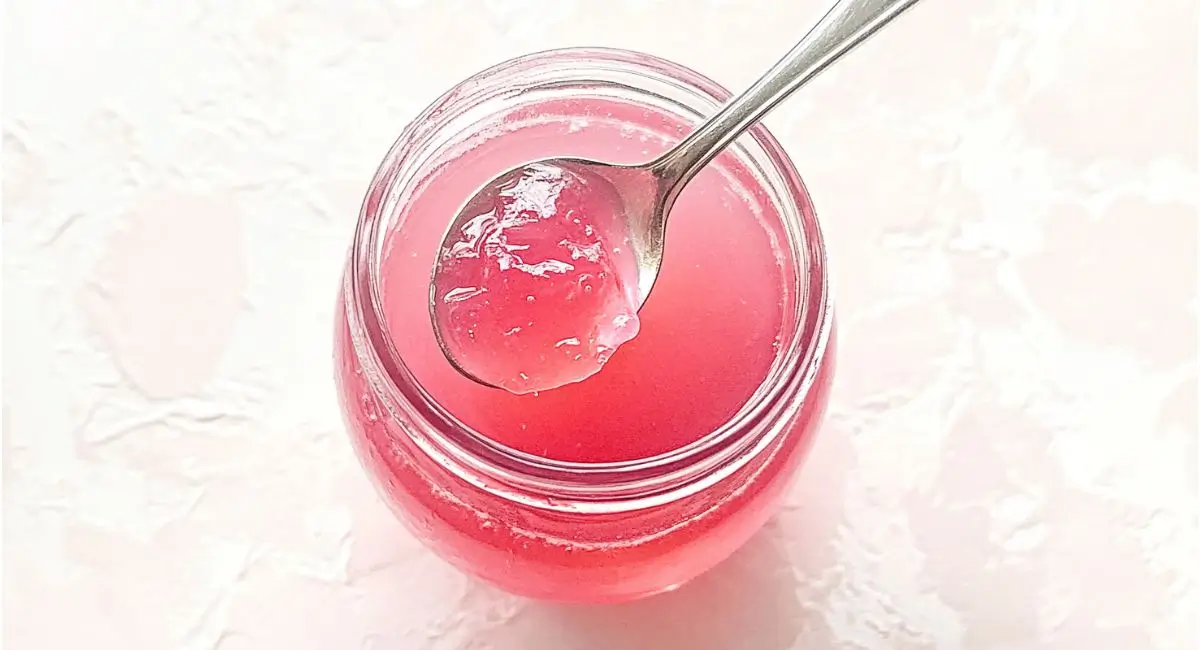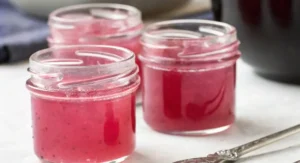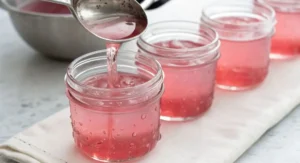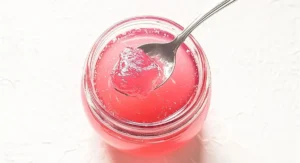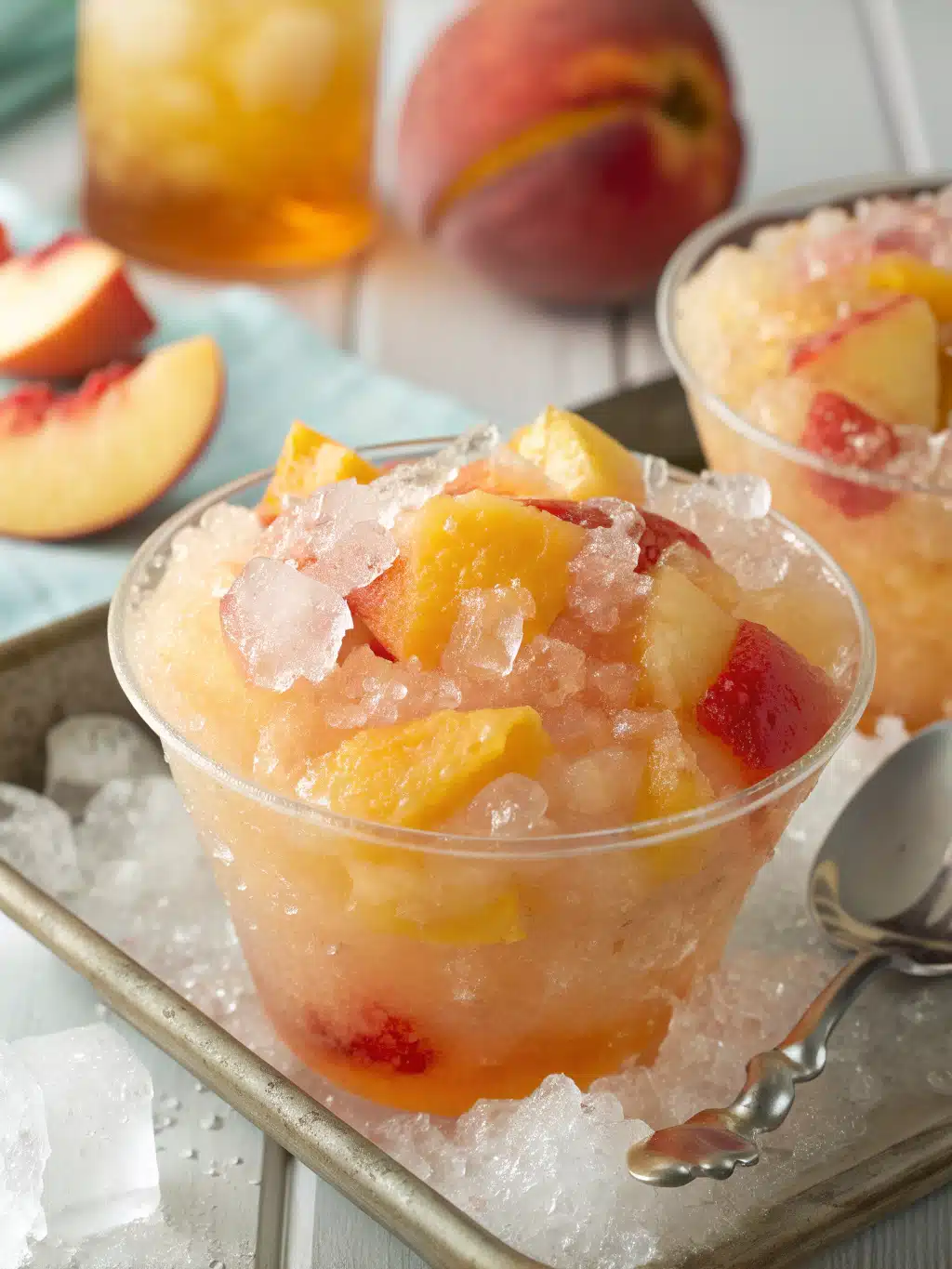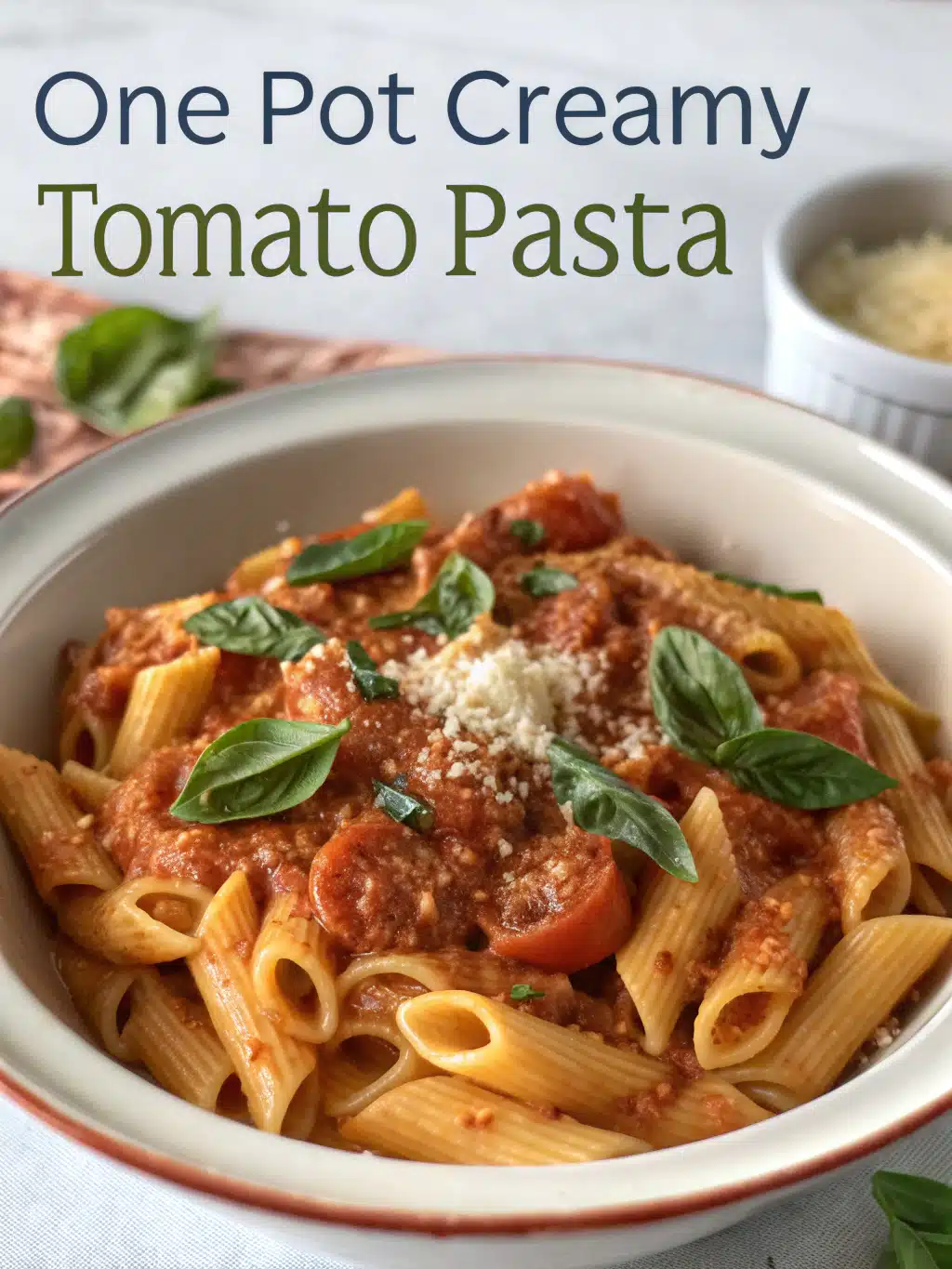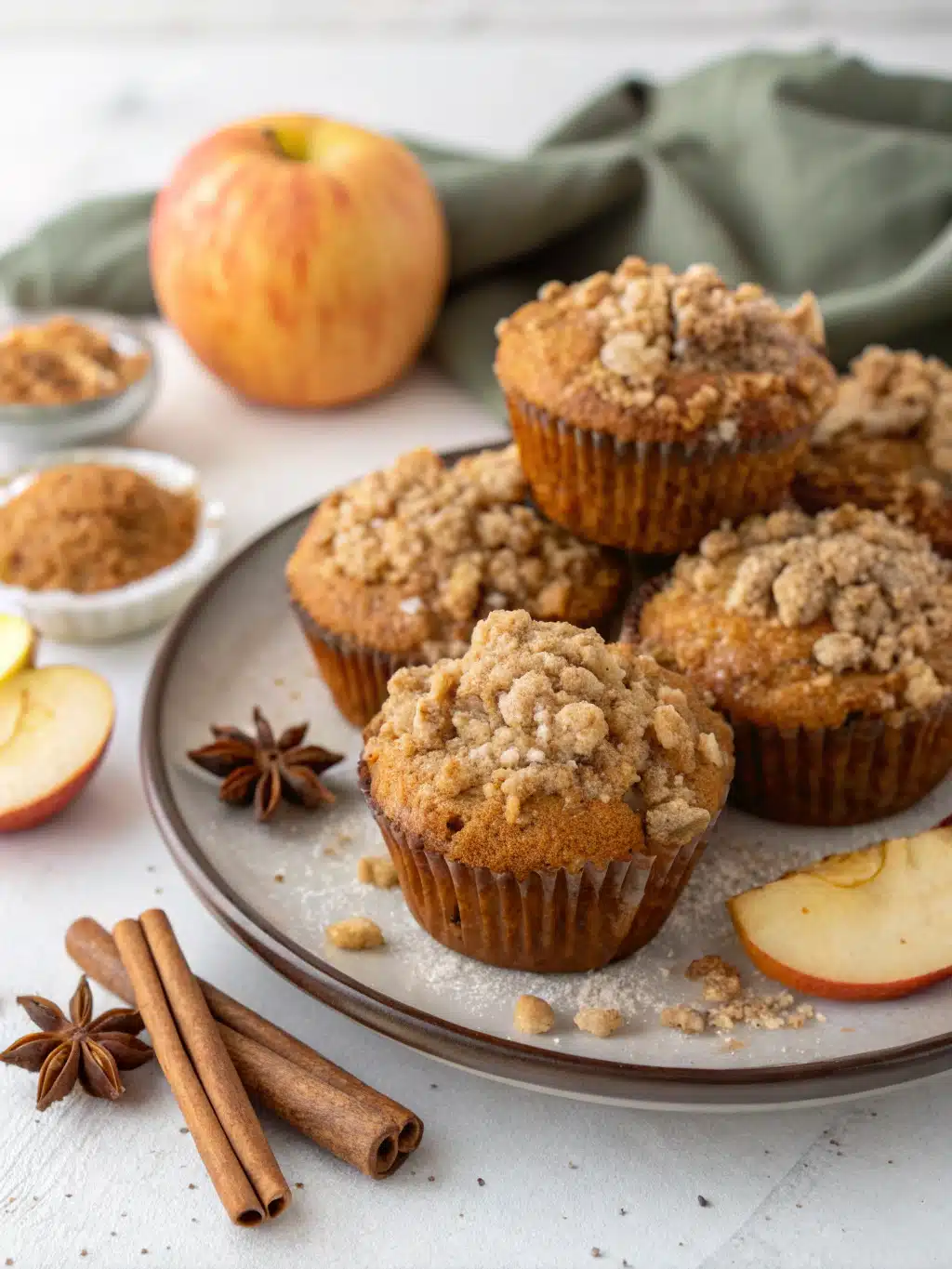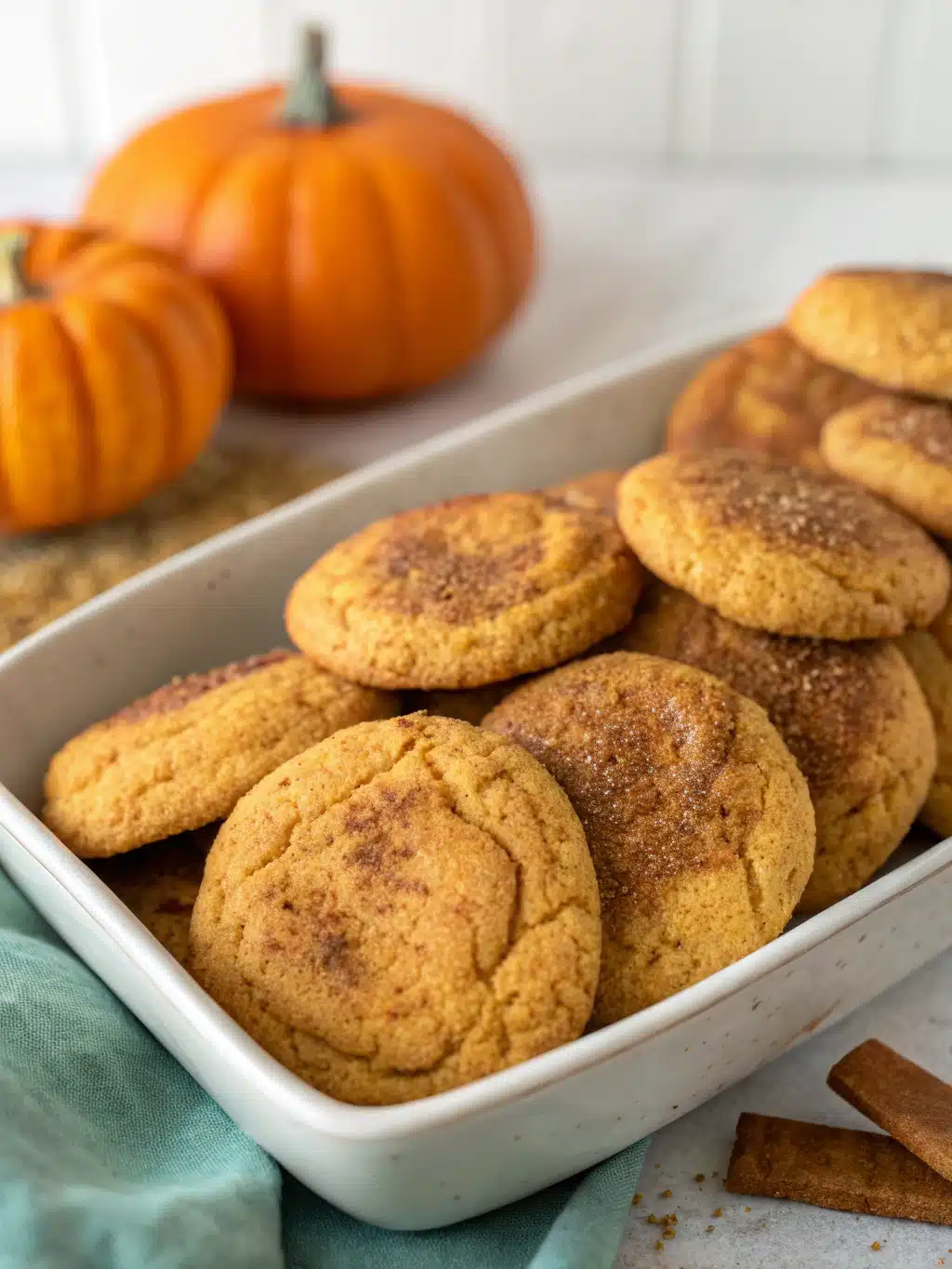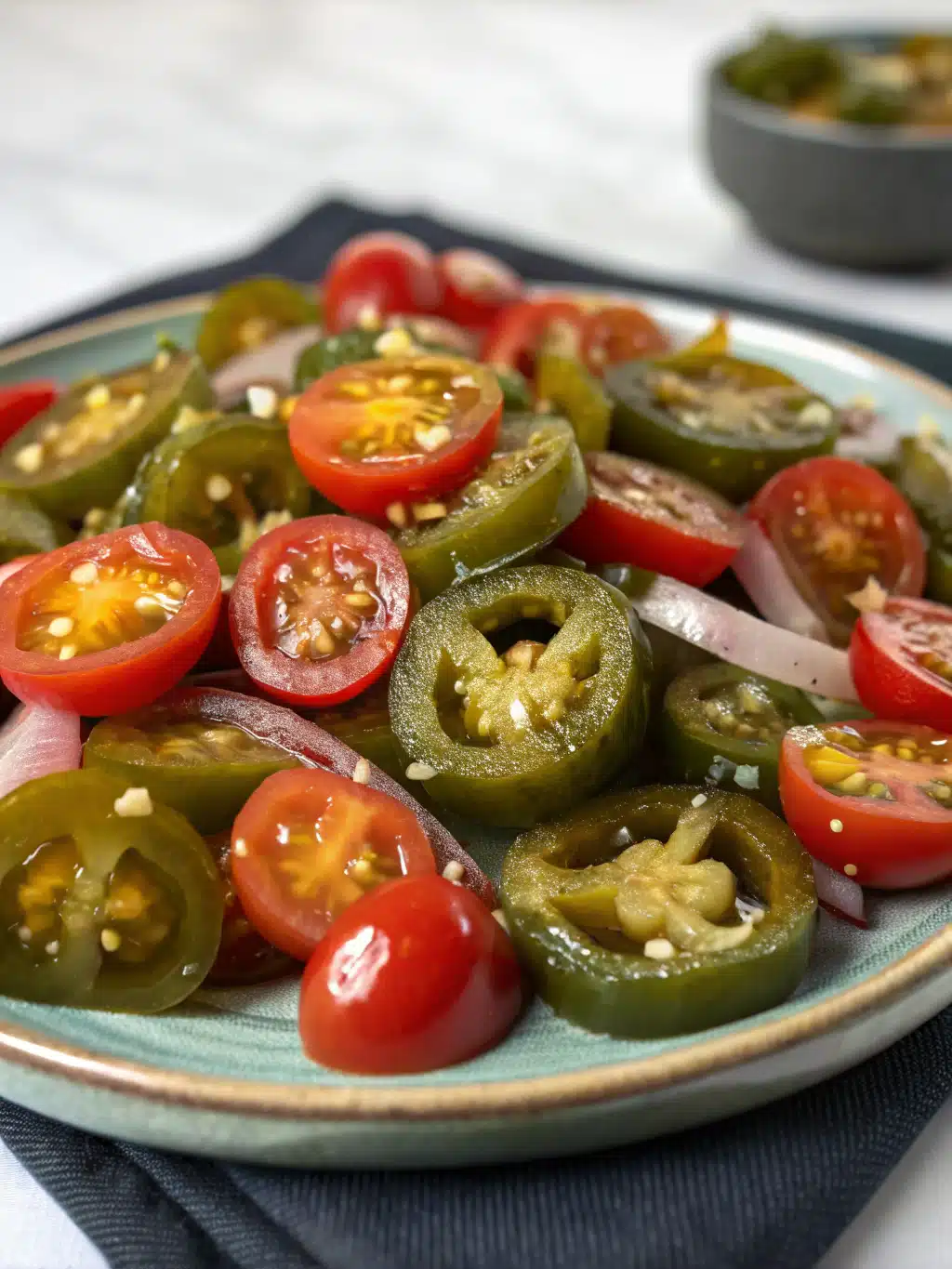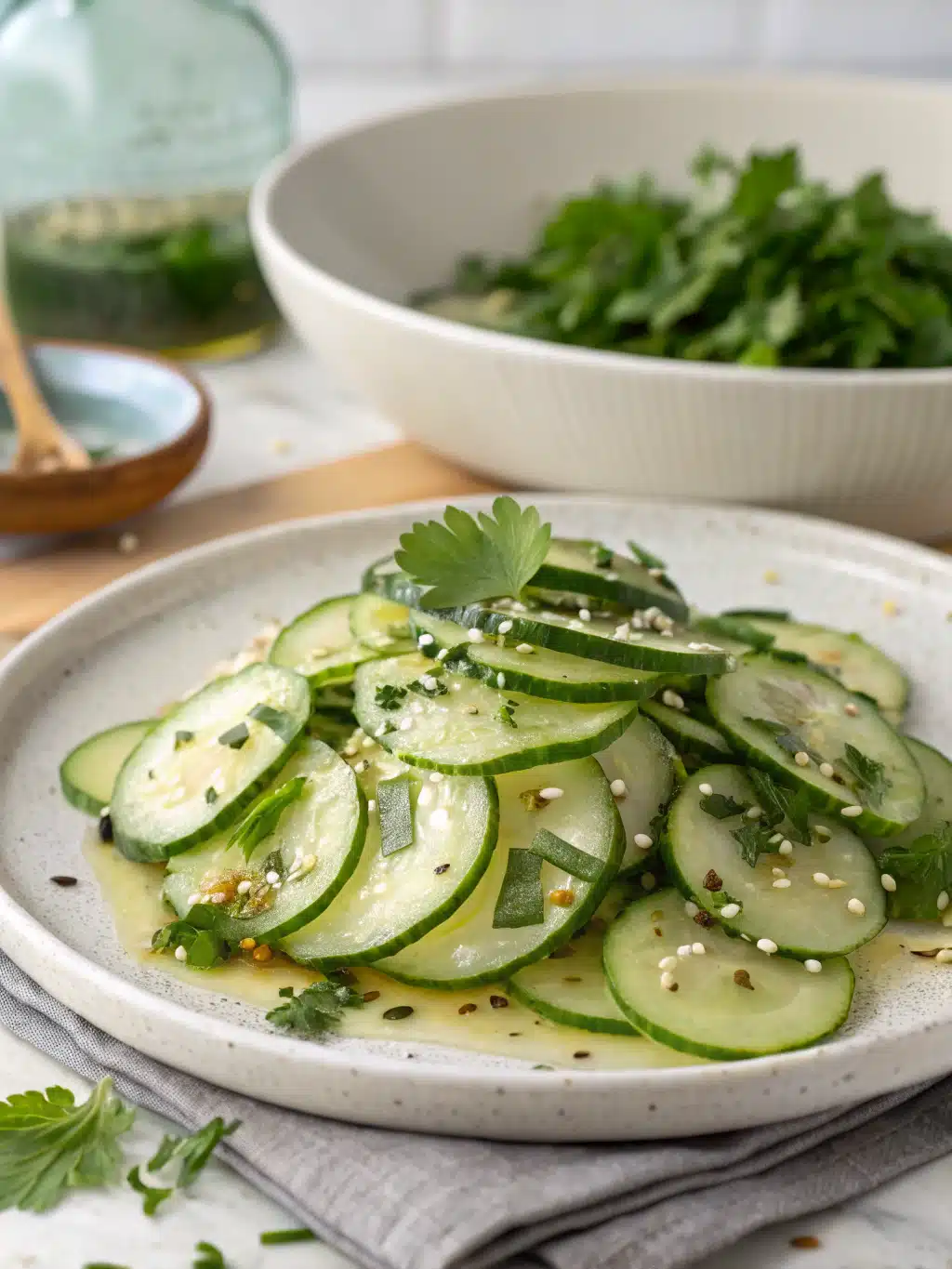Estimated reading time: 12 minutes
Welcome, fellow food enthusiasts and lovers of all things tart and sweet! If you’re looking to capture the vibrant essence of spring in a jar, you’ve come to the right place. This guide is dedicated to crafting the most delicious, shimmering rhubarb jelly recipe you’ve ever tasted. Forget store-bought imitations; homemade rhubarb jelly offers an unparalleled-freshness and the satisfaction of creating something truly special from scratch.
Whether you’re a seasoned-canner or a curious beginner wondering how to make rhubarb jelly, this comprehensive recipe will walk you through every step. We’ll cover everything from selecting the best rhubarb to achieving that elusive perfect set, with options for using pectin and even a guide for a rhubarb jelly no pectin version. Get ready to transform those ruby stalks into jars of jeweled delight!
Table Of Contents
Table of contents
Why You’ll Love This Homemade Rhubarb Jelly Recipe
- Incredibly Flavorful: Captures the unique tartness of rhubarb, balanced perfectly with sweetness.
- Stunning Color: Achieves a beautiful, clear, vibrant pink or ruby red jelly.
- Perfect Set: Our detailed instructions and tips ensure your jelly sets beautifully, avoiding the dreaded “runny rhubarb jelly” syndrome.
- Versatile: Delicious on toast, scones, yogurt, or even as a glaze for meats.
- Comprehensive Guide: We cover ingredient selection, equipment, step-by-step instructions, canning, troubleshooting, and variations.
- Great for Gifting: A jar of homemade rhubarb jelly makes a thoughtful and delicious gift.
Ingredients for Your Rhubarb Jelly Recipe
Getting the best rhubarb jelly starts with quality ingredients. Here’s what you’ll need:
- Rhubarb: About 4 lbs (1.8 kg) fresh rhubarb stalks. This should yield approximately 4-5 cups of rhubarb juice. You can also use frozen rhubarb; see FAQ.
- A Note on Rhubarb: Choose firm, crisp stalks. The color of the stalks (green to deep red) will influence the final color of your jelly. Redder stalks generally produce a more vibrant jelly. Trim off any leaves (they are toxic) and the tough base.
- Granulated Sugar: Approximately 3-4 cups (600-800g), or as specified by your pectin package. Sugar is crucial, not-just for sweetness but also for preservation and achieving a proper set.
- Pectin:
- With Pectin: 1 box (1.75 oz / 49g) of powdered fruit pectin (like Sure-Jell) OR 1 pouch (3 oz / 85ml) of liquid fruit pectin. Follow the specific instructions for your chosen pectin type as quantities and methods can vary.
- No Pectin Option: If making rhubarb jelly without pectin, you’ll rely on the natural pectin in rhubarb and a longer cooking time. You may need more rhubarb for a similar yield.
- Lemon Juice: 1/4 cup (60ml) fresh lemon juice. This adds brightness, helps with pectin activation, and aids in preservation by increasing acidity.
- Water: About 1/2 to 1 cup (120-240ml), just enough to help cook the rhubarb down initially.
- (Optional) Butter or Margarine: 1/2 teaspoon. Helps reduce foaming during boiling, leading to a clearer jelly.
Essential Equipment for Making Rhubarb Jelly
Having the right tools makes the jelly-making process smoother:
- Large, heavy-bottomed stainless steel pot (non-reactive)
- Jelly bag or several layers of cheesecloth lining a colander, set over a large bowl
- Measuring cups and spoons
- Long-handled wooden or silicone spoon for stirring
- Canning jars with lids and rings (e.g., 8-ounce or half-pint jars), sterilized
- Water bath canner with a rack (if processing for long-term storage)
- Jar lifter, canning funnel, and lid wand (magnetic or non-magnetic)
- Ladle
- Small plates (chilled in the freezer for testing the set)
- Candy thermometer (optional but highly recommended for accuracy)
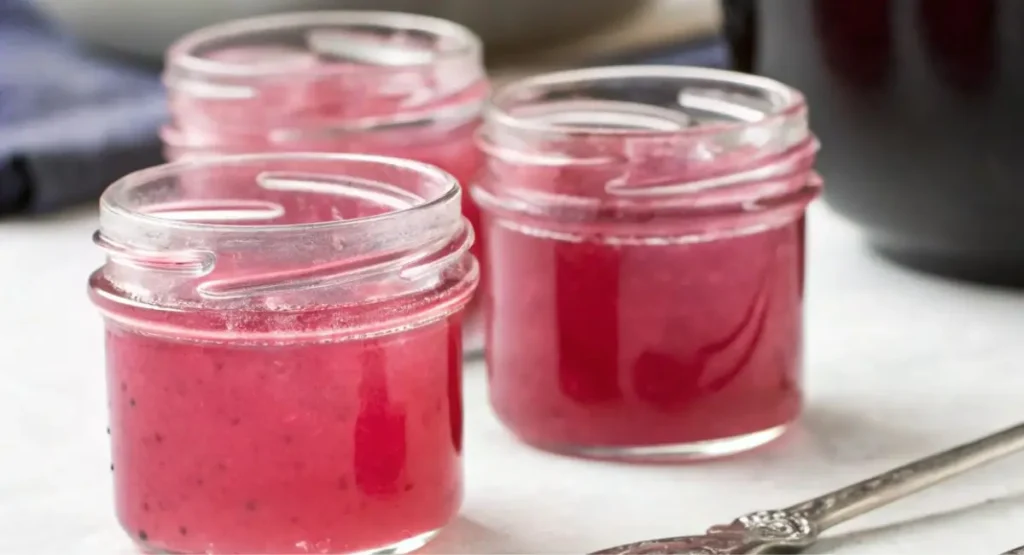
How to Make Rhubarb Jelly (Step-by-Step)
This is our classic rhubarb jelly recipe using pectin. For the no-pectin version, see the dedicated section below.
Step 1: Prepare the Rhubarb
- Wash and Chop: Thoroughly wash the rhubarb stalks. Trim off any tough ends and discard all leaves. Chop the rhubarb into 1-inch pieces. You don’t need to peel it.
- Initial Cook: Place the chopped rhubarb and water into your large pot. Bring to a boil over medium high-heat, then reduce-heat, cover, and simmer for 10-15 minutes, or until the rhubarb is very soft and falling-apart. Stir occasionally to prevent sticking.
Step 2: Extract and Strain the Rhubarb Juice
This step is crucial for a clear, beautiful jelly.
- Set Up Strainer: Position your jelly bag or cheesecloth-lined colander over a large, clean bowl.
- Strain Juice: Carefully pour the cooked rhubarb mixture into the prepared strainer. Allow the juice to drip through naturally. This can take several hours, or you can let it drip overnight in a cool place (or the refrigerator).
- For Clearer Jelly: Resist the urge to squeeze the bag or press the pulp, as this can make your jelly cloudy. If you’re not concerned about perfect clarity, you can gently squeeze to extract more juice.
- Measure Juice: You should have about 4-5 cups of rhubarb juice. If you have slightly less, you can add a little water to reach the desired amount, but pure juice is best for flavor.
Step 3: Combine Ingredients and Cook the Jelly
- Combine Ingredients: In your clean, large, heavy-bottomed pot, combine the measured rhubarb juice, lemon juice, and pectin (if using powdered pectin, whisk it into the juice before heating to prevent clumps). If using liquid pectin, you’ll add it later.
- Bring to a Boil: Place the pot over high-heat and bring the mixture to a full rolling-boil that cannot be stirred down. Stir constantly.
- Add Sugar: Once at a full rolling boil, add all the sugar at once. Stir continuously to dissolve the sugar.
- Return to Boil: Continue stirring and bring the mixture back to a hard, rolling boil. Boil vigorously for exactly 1 minute (if using Sure-Jell or similar powdered pectin – always follow your specific pectin’s instructions). If using liquid pectin, add it now and boil for 1 minute. Add the optional 1/2 teaspoon of butter/margarine here to reduce foam.
Step 4: Testing for Set Point
Achieving the correct set is vital. Here are a few ways to test:
- Thermometer Test (Most Accurate): The jelly is at its set point when it reaches 220°F (105°C) at sea level. Reduce temperature by 1°F for every 500 feet above sea level.
- Wrinkle Test: Before you start cooking, place a few small plates in the freezer. To test, remove the pot from the heat. Place a small spoonful of jelly onto a chilled plate. Return it to the freezer for 30-60 seconds. Push the jelly with your finger. If it wrinkles slightly, it’s set. If it remains liquid, continue cooking for a few more minutes and test again.
- Sheet Test (More Advanced): Dip a cool metal spoon into the boiling jelly. Lift it and allow the syrup to drip off the side. If the jelly is not ready, the drips will be thin and syrupy. As it nears the set point, the drips will become heavier. When ready, the last two drops will hang and then merge, “sheeting” off the spoon.
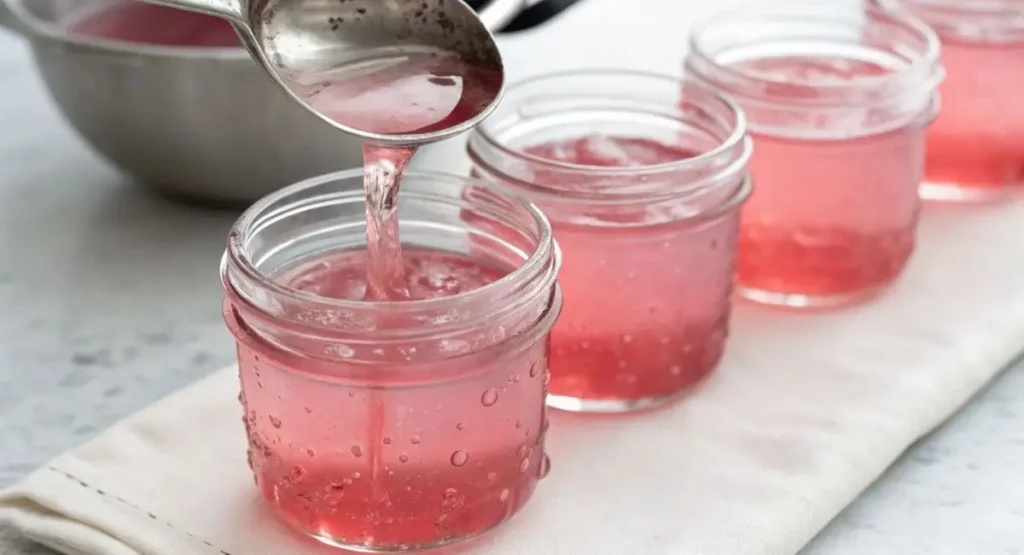
Step 5: Skim and Pot the Jelly
- Remove from Heat: Once the set point is reached, remove the pot from the heat.
- Skim Foam: Skim off any-foam from the surface using a metal spoon. This results in a clearer, more attractive jelly.
- Fill Jars: Using a canning-funnel and ladle, carefully pour the hot-jelly into sterilized jars, leaving 1/4-inch headspace (the-space between the top of the jelly and the rim of the jar).
- Wipe Rims & Seal: Wipe the jar rims clean with a damp cloth. Place the sterilized lids on top and screw on the rings until fingertip tight (not too tight).
Canning Rhubarb Jelly (Water Bath Method for Long-Term Storage)
If you want your rhubarb jelly recipe to be shelf-stable, process it using a water bath canner.
- Prepare Canner: Ensure your water bath canner has enough hot (not-boiling) water to cover the jars by at least 01 inch.
- Load Jars: Carefully place the filled jars onto the rack in the canner using a jar lifter. Ensure jars are not touching each other.
- Process: Add more hot water if needed to cover jars. Bring the water to a rolling boil. Once boiling, cover the canner and process the jars for 10 minutes (adjust processing time for altitude if necessary).
- Cool: Turn off the heat, remove the canner-lid, and let the jars-sit in the hot water for 05 minutes. Then, carefully-remove the jars using a jar lifter and place them on a towel-lined surface, leaving space between them.
- Check Seals: Let the jars cool completely for 12-24 hours undisturbed. You should hear a “pop” sound as they seal. Once-cool, check the seals by pressing the center of the lid. If it doesn’t flex up and down, it’s sealed. If a jar doesn’t seal, store it in the refrigerator and use it within a few weeks.
Making Rhubarb Jelly Without Pectin
If you prefer a rhubarb jelly no pectin version, the process is similar but requires more attention to cooking time and testing for set.
- Extract Juice: Prepare and extract rhubarb juice as described in Steps 1 & 2.
- Combine and Cook: Combine 4 cups of rhubarb juice, 3-4 cups of sugar (you might need less sugar without commercial pectin’s setting power, taste as you go but ensure enough for preservation), and 1/4 cup lemon-juice in your pot.
- Boil: Bring to a boil, stirring to dissolve sugar. Continue to boil rapidly, stirring frequently.
- Test for Set: This will take longer than with pectin, possibly 20-40 minutes or more of vigorous boiling. Start testing for set (using the wrinkle or sheet test) after about 15-20 minutes of hard boiling. The thermometer test (220°F / 105°C) is most reliable here.
- Pot and Process: Once the set point is reached, skim foam, pot into sterilized jars, and process in a water bath canner as described above.
Note: Jellies made without added pectin may have a slightly softer set and can take longer to fully firm up after jarring (up to 48 hours).
Tips for Perfect Rhubarb Jelly Every Time
- Don’t Double Batches: It’s tempting, but making jelly in smaller batches (as per the recipe) ensures it heats and cooks evenly, leading to a better set.
- Use a Wide Pot: A wider pot provides more surface area for evaporation, helping the jelly reach its set point faster.
- Stir, Stir, Stir: Especially after adding sugar, stir constantly to prevent scorching and ensure even cooking.
- Accurate Measurements: Jelly making is a science. Measure your ingredients accurately.
- Patience with Straining: For the clearest jelly, let gravity do the work when straining the juice.
Troubleshooting Common Rhubarb Jelly Issues
- Why is My Rhubarb Jelly Runny? / My Rhubarb Jelly Didn’t Set! This is the most common issue. Reasons include:
- Not enough boiling: The jelly didn’t reach the set point.
- Incorrect measurements: Too little sugar or pectin, or too much liquid.
- Pectin issues: Old pectin, or pectin not incorporated correctly.
- How to Fix Runny Rhubarb Jelly: You can try re-cooking it. Pour the unset jelly back into the pot. For every 4 cups of jelly, you can try adding 1-2 tablespoons of lemon juice and re-boiling, or add more pectin according to package re-cook instructions (often involves adding more sugar and pectin). Boil vigorously and re-test for set.
- Why is My Jelly Cloudy?
- Squeezing the jelly bag.
- Using underripe rhubarb.
- Allowing the jelly to boil too slowly for too long, or not skimming foam adequately.
- Sugar Crystals in Jelly:
- Too much sugar, or sugar not fully dissolved.
- Undissolved sugar crystals on the side of the pot falling in. Wipe down pot sides with a damp pastry brush during cooking.
Flavor Variations & Additions
While classic rhubarb jelly is divine, try these twists:
- Rhubarb and Ginger Jelly: Add 1-2 tablespoons of finely grated fresh-ginger or 01 teaspoon of ground ginger to the rhubarb juice before cooking.
- Rhubarb Vanilla Jelly: Add the seeds of 01 vanilla bean or 01 teaspoon of vanilla extract to the jelly after removing it from the heat and skimming, just before potting.
- Rhubarb Strawberry Jelly: Replace 1 cup of rhubarb juice with 1 cup of strained strawberry juice for a classic combination.
- Spiced Rhubarb Jelly: Add a cinnamon stick or a star anise to the rhubarb while it’s initially cooking, then remove before straining.
How to Store Homemade Rhubarb Jelly
- Sealed Jars: Properly processed and sealed jars can be stored in a cool, dark, dry place for up to 1-2 years.
- Unsealed or Opened Jars: Store in the refrigerator and use within 1 month.
Serving Suggestions for Rhubarb Jelly
This vibrant jelly is more versatile than you might think!
- Spread on toast, crumpets, scones, or English muffins.
- A delightful filling for thumbprint cookies or pastries.
- Serve with cheese boards, especially creamy cheeses like brie or goat cheese.
- Use as a glaze for roasted chicken, pork, or ham.
- Swirl into yogurt or oatmeal.
- A topping for pancakes or waffles.
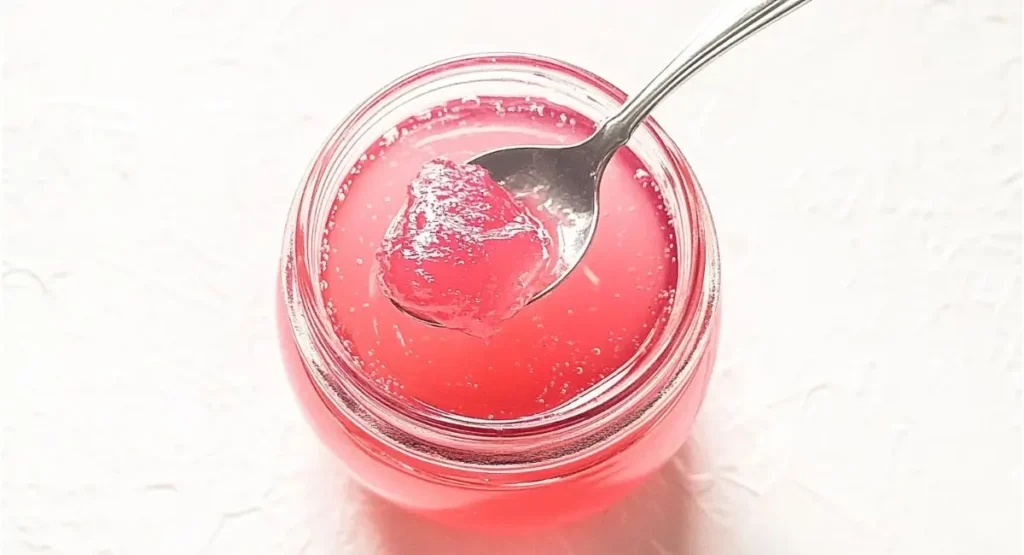
Frequently Asked Questions (FAQ)
u003cstrongu003eCan I use frozen rhubarb for jelly?u003c/strongu003e
Yes! Thaw the frozen rhubarb and use it, along with any accumulated juices, as you would fresh.
u003cstrongu003eHow much sugar for rhubarb jelly?u003c/strongu003e
The amount varies, but a common ratio is close to 1:1 sugar to juice by volume when using commercial pectin. Sugar is vital for set and preservation. Reducing it too much can lead to a runny or spoiled product unless using special low-sugar pectin.
u003cstrongu003eWhat does rhubarb jelly taste like?u003c/strongu003e
It has a unique sweet-tart flavor profile, intensely rhubarby, with a bright, tangy finish. The sweetness balances the natural tartness of the rhubarb.
u003cstrongu003eHow long does it take for rhubarb jelly to set?u003c/strongu003e
It should reach its setting point during cooking. Once potted, it will continue to firm up as it cools. It can take up to 24-48 hours for the final set to establish, especially for no-pectin versions.
Conclusion
Crafting your own rhubarb jelly recipe is a rewarding experience, filling your kitchen with delightful aromas and your pantry with jewel-toned jars. We hope this comprehensive guide empowers you to create the most delicious homemade rhubarb jelly with confidence. Enjoy the process and the sweet, tart rewards! Happy jelly making!
Related Recipes You Might Enjoy
Did You Make This Recipe!
There are no reviews yet. Be the first one to write one.
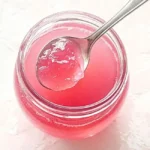
The Ultimate No-Fail Rhubarb Jelly
- Total Time: 1 hour 10 minutes
- Yield: 5 cups
Description
Capture the vibrant essence of spring with this delicious, shimmering homemade rhubarb jelly! This comprehensive guide walks you through creating the perfect set every time, whether you’re using pectin or trying our no-pectin variation. Enjoy this sweet-tart delight on toast, scones, or as a glaze.
Ingredients
- 4 lbs fresh rhubarb stalks (approx. 1.8 kg, yields 4–5 cups juice)
- 3–4 cups granulated sugar (600-800g, or as per pectin package)
- 1 box powdered fruit pectin (1.75 oz / 49g, e.g., Sure-Jell – OR 1 pouch liquid pectin, 3 oz / 85ml)
- 1/4 cup fresh lemon juice (60ml)
- 1/2 – 1 cup water (120-240ml, for initial rhubarb cook)
- 1/2 tsp butter or margarine (optional, to reduce foam)
Instructions
- Prepare Rhubarb: Wash, trim (discard leaves!), and chop rhubarb into 1-inch pieces.
- Initial Cook: In a large pot, combine chopped rhubarb and water. Bring to a boil, reduce heat, cover, and simmer for 10-15 minutes until very soft.
- Extract Juice: Pour cooked rhubarb into a jelly bag or cheesecloth-lined colander set over a large bowl. Let drip for several hours or overnight. Do NOT squeeze for clearest jelly. Measure out 4-5 cups of juice.

- Combine & Start Cooking: In a clean, large pot, combine rhubarb juice, lemon juice, and powdered pectin (if using). Whisk well. Bring to a full rolling boil over high heat, stirring constantly.
- Add Sugar: Add all the sugar at once. Stir continuously to dissolve and return to a hard, rolling boil (a boil that cannot be stirred down).

- Boil: Boil vigorously for exactly 1 minute, stirring constantly. (If using liquid pectin, add it after sugar is dissolved and mixture returns to a boil, then boil for 1 minute). Add optional butter now to reduce foam.
- Test for Set: Remove from heat. Test for set using a chilled plate (jelly wrinkles when pushed) or a thermometer (220°F / 105°C at sea level).
- Skim & Pot: Skim any foam from the surface. Carefully ladle hot jelly into sterilized jars using a canning funnel, leaving 1/4-inch headspace.

- Seal Jars: Wipe jar rims clean. Place lids on and screw rings until fingertip tight.
- Process (Water Bath): Place jars in a prepared water bath canner. Ensure water covers jars by at least 1 inch. Bring to a rolling boil, cover, and process for 10 minutes (adjust for altitude).
- Cool: Turn off heat, let jars sit in canner for 5 minutes. Remove jars and place on a towel-lined surface to cool completely (12-24 hours). Check seals (lid should not flex).
Notes
Rhubarb Prep: Always discard rhubarb leaves as they are toxic. The color of your rhubarb stalks will influence the final jelly color.
Clear Jelly: For the clearest jelly, allow the juice to drip naturally without squeezing the jelly bag.
No-Pectin Version: To make without commercial pectin, combine 4 cups rhubarb juice, 3-4 cups sugar (adjust to taste), and 1/4 cup lemon juice. Boil rapidly, stirring frequently, for 20-40+ minutes, until it reaches the set point (220°F / 105°C or wrinkle test). This version may have a softer set.
Testing for Set: The thermometer method (220°F / 105°C) is most reliable. Adjust for altitude (reduce 1°F for every 500 ft above sea level).
Troubleshooting Runny Jelly: If jelly doesn’t set, it can sometimes be re-cooked. Consult reliable canning resources for re-processing instructions.
Storage: Sealed jars store in a cool, dark place for 1-2 years. Refrigerate after opening and use within 1 month. Unsealed jars must be refrigerated.
Flavor Variations: Add 1-2 Tbsp grated fresh ginger or 1 tsp vanilla extract (after cooking) for a flavor twist.
Altitude Adjustment: If you live at high altitude, increase water bath processing time according to USDA guidelines.
- Prep Time: 30 minutes
- Cook Time: 40 minutes
- Category: Breakfast, Dessert
- Cuisine: American

